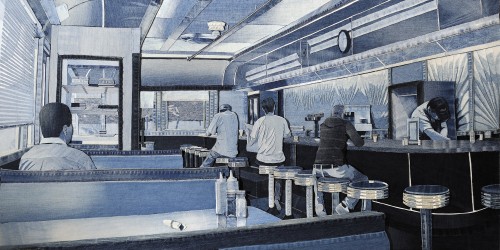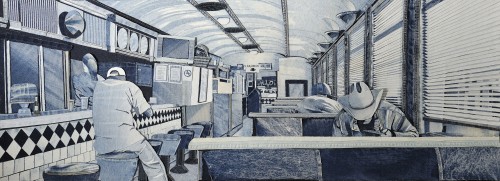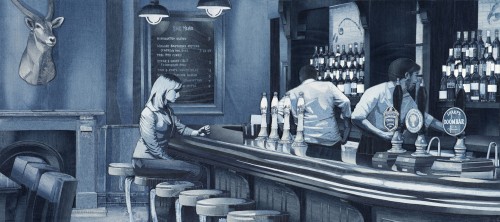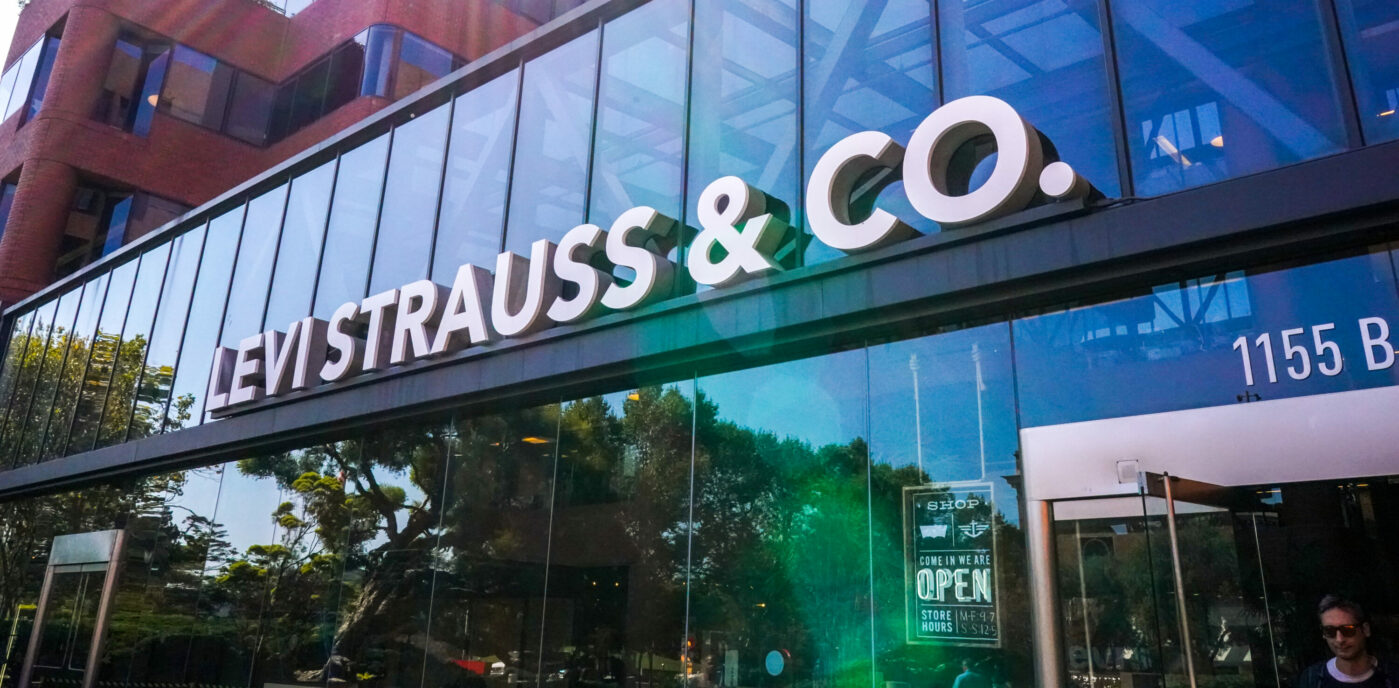For Ian Berry, aka Denimu, blue jeans aren’t just the article of clothing he puts on every day—they’re his way of looking at the world. The Yorkshire native painstakingly assembles denim scraps to depict the scenes that surround him. Up close, the rips, frays and whiskers lend extreme textural interest to Berry’s pieces. But from a distance, indigo’s high contrast and gradient fades create a stunning illusion of depth, light, and ultimately, photorealism.
We’re not the only ones who have taken notice of the artist’s mind-blowing creations. He has garnered quite the following in London, and worldwide, with works often selling even before they’ve hit the gallery floor.
Unzipped had the great pleasure of chatting with Berry about his process and passion.
UNZIPPED: Tell us how you began working with denim.
IAN BERRY: I was always the kid who wanted to be an artist, but I wound up going down the commercial art route, into advertising. After university, I was planning to move to London to get a job. Since I was leaving home for good, my mom decided to redecorate my old bedroom and get rid of all my old stuff—including a big pile of jeans. It was then, cleaning out my room, that I noticed all the different textures, shades and colors of the denim together. I thought that it would make a really interesting medium for a piece of work.
When I started, it was purely aesthetic. Also, I didn’t want to throw my favorite jeans away even though they didn’t fit anymore—it linked to all these memories. As I have worked with denim, a lot more meaning has come into it.
I realize now that I am only comfortable wearing jeans. And it has also become my medium that I am comfortable using. I see things in denim. I daydream and imagine how I would make something out of denim. If I am in a conversation with someone, I am looking at their face and seeing it in different shades of denim. It gets quite weird actually.
How has your work evolved over time?
The thing that has evolved the most is the way that I have used the denim and the way I see the denim. My aim now is to push the photorealism and the technical skill.
When I started, I was using blocked colors of jeans, where the jean pieces stay the same shade. My portraits look like they were done with paint—with a pallet knife. Now, I use the shade variations within the jeans and play with high contrast, for instance, making the illusion of a shiny surface out of this matte material. This gives the work a more photorealist quality.
I’ve overheard people say, “I didn’t even realize that was made out of denim!” That’s really cool. Although there is still a big part of me that wants them to know it’s denim, it seems even more more amazing to me when they don’t initially realize that.
How do you choose your subject matter?
I started with faces: people who wore iconic in denim history: James Dean, Marilyn. I thought it was important to commemorate them. Jeans are everywhere and these people’s faces are also everywhere, so there’s some irony there.
Now I am trying to work bigger and put more narrative into the work with my city scenes. I live in rural Sweden. But most of my scenes are of urban areas—London and New York. I think that’s a bit of my craving to go back to those places. I love the feeling of cities but they can also be quite lonely. So, in my works, there is often a girl solo at the bar or a man eating alone in a diner—that melancholy feel. And although denim started off as a rural working fabric, today I see it as more of an urban fabric and the material of our time.
Tell me about your technical process.
I work from photographs. I used to use a Photoshop filter to map pieces out, but now I work directly from the color photo—I can visualize it easier from that.
It takes extreme concentration. I only work on one artwork at a time, cause I need to really focus on which shade of denim I am using. If I lose one of the shades or use the wrong shade, it screws everything up. It’s really technical.
I am getting more jeans now, and that makes the work a lot better because I can find the shades and textures that I need. But I also have so many options that it takes a lot longer to find and choose. It can take me half a day to find the right shade for one little piece.
What has been the reaction to your work?
I have a completely empty studio right now because everything has sold. It sounds good, but it is actually quite stressful because then I don’t have work to show, and people want to come see the studio, or people want to exhibit the work in museums, and I’ve got nothing left!
In your artist statement you say, “Denim is a reflection of the world in which we live.” Elaborate.
Where do I start? Denim is common in just about every country in the world. The rich, the poor, the big, the skinny—everyone has a jean that they feel the most comfortable in. It is something that we see every day and my work allows people to see it in a different context.
Also, denim is for everyone. Art should be too. A lot of people who are not familiar with art have come in to see my work and really enjoyed the experience. That feels great! I was the guy who wanted to be an artist but was told there was no career in that. It has become a life mission to tell kids: You can do it. There’s nothing wrong with a 9-to-5, but do what you want to do and follow your dreams.











